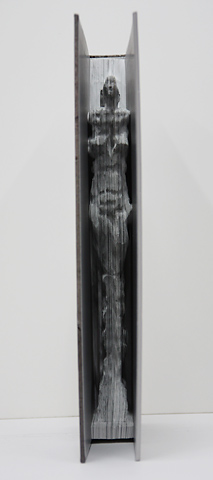artist book: a work of art realized in the form of a book
The definition may sound simple, but the world of artist books can be a bewildering place. From the familiar pairing of images and text, to sculptures created out of paper and complicated bindings that create a performance each time the book is opened, nearly anything can be called an artist book if there is intention and consideration. This monthly series will showcase artists from different realms of the art world exploring the structure and meaning of the book.
Noriko Ambe is a Japanese born artist with a BFA in oil painting from Musashino Art University in Tokyo. She arrived at paper and books as a medium for her work through a problem common to many artists: dissatisfaction with her current methods. She says of her paintings, “I was kind of describing the landscape but I wanted to be the nature somehow…” After exploring drawing and binding she came to the realization that the paper was all she needed, “…I can cut directly and make a sculpture piece.”
Here Ambe found the medium for her work. Her sculptural monotone landscapes in combination with the overarching title Flat Globe allude to a conversation about nature, humans, and time, showing, “…absolutely traces of my action which means human being exist the same as nature.” Starting with a stack of yupo paper, each layer is cut one at the time and moved aside into a new stack—a human reenacting nature and slowly eroding a material layer by layer.
Flat Globe
In 2009, Ambe embarked on the Artist Books Project with curator Glenn Fuhrman in which she would study an artist’s work, decide on a theme that she needed to express within it, and then begin to create. Through cutting into pages and altering these monographs, Ambe inserted herself into these artists’ works as a mediating filter; the viewer sees her view and understanding of the selected artist. Similar to a way a photographer could choose to show you the most important part of an event by capturing a single moment with a particular lens, camera, and lighting, Ambe has created visual shortcut to the essence of these artists’s works without any inherent judgement or explicit commentary.
To Perfect Lovers: Felix Gonzalez-Torres, 2010
Listening to Tom Freidman: Tom Freidman, 2009
Anatomy of Love: John Currin, 2009
In Ambe’s work there is a playfulness with her chosen subjects, a wry nod in her titling of the pieces. To Perfect Lovers: Felix Gonzalez-Torres nods to her Perfect Lovers piece in which two synchronized clocks are placed closely on a wall—ticking through time together yet separate, inspiring the viewer to question whether or not they will stay in sync (see the original here). Ambe’s version is an attempt at paired synchronicity in her own visual language: paper cutting; both deal with the passage of time and hopefulness of a existing in pairs when fallible human nature is involved.
Art Victims: Damien Hirst, 2009
A Study of Robert Therrien: Robert Therrien, 2009
The Sand - The Americans: Robert Frank, 2011
As she has said, Noriko Ambe is making “an offering to the god of art,” and starting a conversation with artists past and present. Being able to view the result of her absorption and digestion of an artist’s works in akin to being able to talk about the art with her. By selecting mass produced printed catalogs she has created a less-coded entry point for her viewers to understand and engage in a conversation about contemporary artists. Ambe’s Flat Globe works are adored because they are able to transport the viewer into a world where an imagined geography can be made tactile and stay pure and unadulterated. Artist Books Project utilizes Ambe’s visual language, deconstructing and reconstructing an artist’s works in an ode to the process and result.
In the Studio: Alberto Giacometti, 2009
Margret Hall is a book artist and photographer living and working in Asheville, NC. Before moving to Asheville to train in book restoration (and live life in the mountains), she taught book arts at The Art Institute of Boston at Lesley University, where she also received her BFA in Photography with a minor in Art History and Book Arts.












































































































































































































